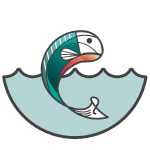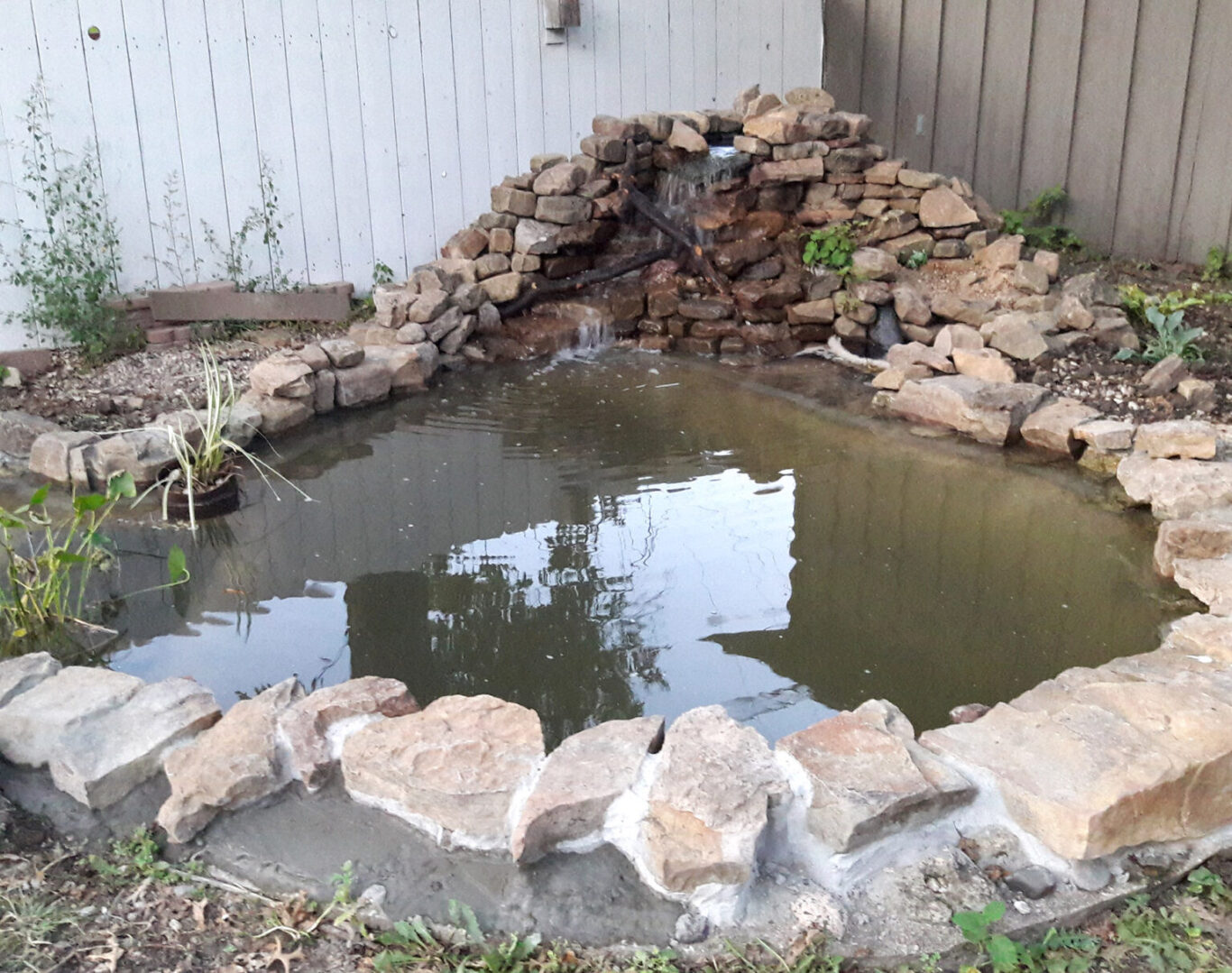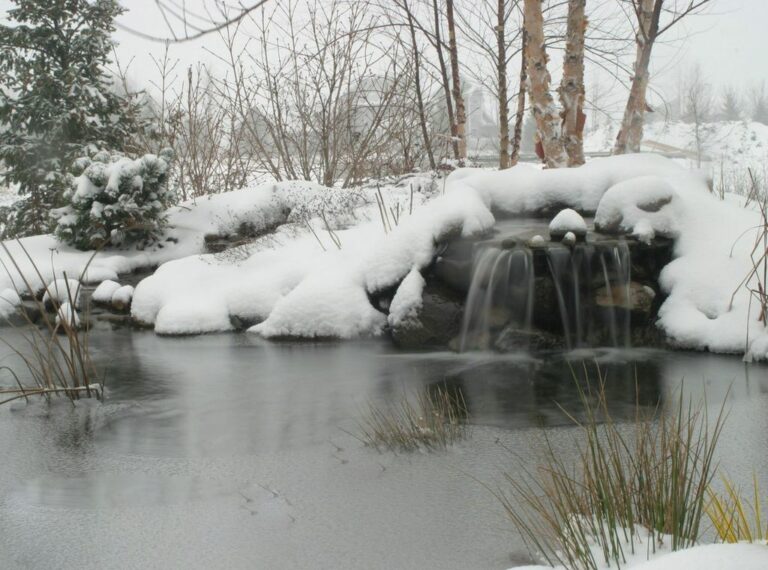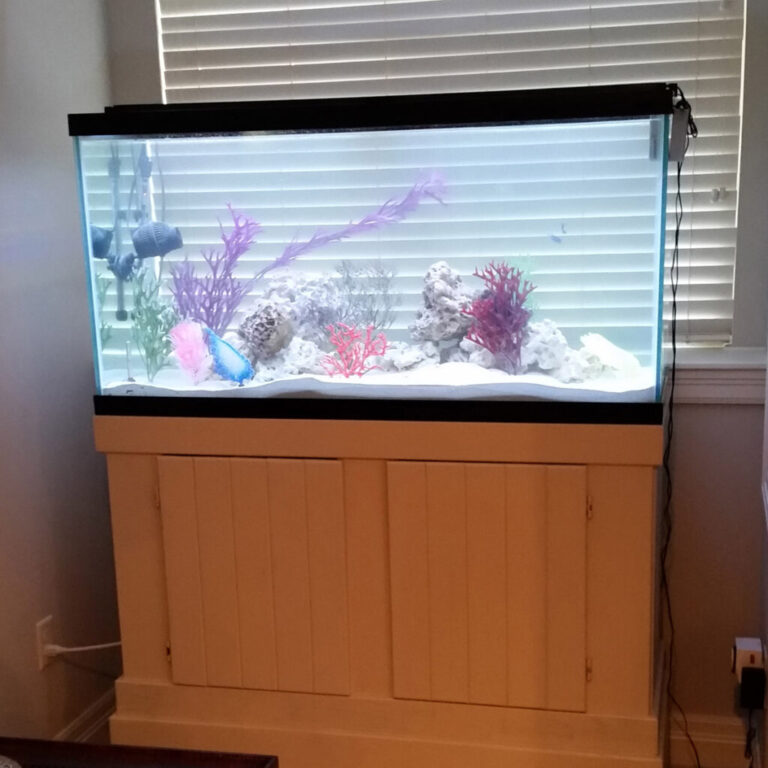Maturing A New Pond: The Nitrogen Cycle, New Pond Syndrome, and Pea Soup Algae Control
The Pond Nitrogen Cycle
Nitrogen is essential for all living cells. The nitrogen cycle is the process by which decaying organic nitrogen compounds-and also specifically toxic ammonia waste- are oxidized. Establishing the nitrogen cycle is the key to maturing a new pond. At any time, ammonia and further-oxidized nitrogen compounds may be consumed by plants and algae: ammonia, nitrite, and nitrate are the basic fertilizer nutrients for photosynthetic organisms. Your plants and fish will thrive with low levels of nitrogenous waste. However, algae proliferates from excesses of nutrients. Therefore, to reduce algae and mature a new pond, you must give your pond way to establish the nitrogen cycle.
Decaying plant and fish waste create ammonia
The nitrogen cycle begins with ammonia. It is produced from eaten fish food, excreted as ammonia in urine, respired ammonia, ammonia from oxidized amino acids, unprocessed amino chains and cellular material in feces, or shed mucus (slime coat). The remainder of the feces, along with uneaten fish food, dead plant matter, and most catastrophic for your pond- dead organisms- are further decomposed into ammonia by fungi, detritivores (i.e. larvae, scuds, planaria) and microscopic bacteria.
Ammonia is converted into nitrite
Ammonia is highly toxic in alkaline water (alkaline water is water with pH greater than 7, which is neutral.) Your pond should have a pH greater than 7, but less than 8. Your plants cannot consume enough ammonia to keep it from reaching lethal levels to fish, but the wet surfaces of your pond are covered by an invisble blanket of nitrosamonas bacteria. This “good bacteria” converts ammonia into nitrite.
In order to oxidize the ammonia into nitrite, these bacterium must also consume oxygen and carbonate. If your carbonate hardness drops below 50 ppm (3dKH), Nitrosamonas may enter dormancy, resulting in a “pond crash”.
Nitrite is converted into nitrate
The resulting nitrite is a toxic waste byproduct, but not as deadly as ammonia. Nitrite is readily consumed by your plants. However, plants alone cannot consume enough nitrite to detoxify the water. And once again, another protective blanket of aerobic bacteria work steadily to oxidize toxic nitrite. Bacterium of the Nitrobacter genus live on well-oxygenated surface areas in the pond, and can quickly metabolize nitrite into nitrate when they are exposed to ample amounts of oxygen. These bacteria thrive on surfaces where oxygen-rich water flows. Yet nitrobacter work very slowly when they are in low to moderate-oxygen environments, so if your pond is heavily stocked with goldfish or koi, a waterfall may not help you enough. If you have more than a few koi, your pond design needs a submerged undergravel filter or an external bead filter.
Low levels of nitrates are the end result of a mature pond
Finally, the resulting nitrate is only toxic in high levels. It must be removed from the pond in one of 4 ways: thru plants as fertilizer, thru algae as fertilizer, thru pond-water changes, or thru de-nitrifying bacteria. The slow, uninteresting process of de-nitrification is anaerobic, meaning these bacteria must work in an environment absent of oxygen, such as the deepest nooks of the pond rocks. A more interesting fact is that rainwater from thunderstorms will increase your nitrate, because lightning fixes atmospheric nitrogen. This can sometimes cause pea-soup syndrome. In such cases, we recommend you add Aqua-One bacteria and a barley straw bale.
Maturing a new pond requires plants
Because denitrifying bacteria are not effective at reducing nitrates, we recommend you establish some “bog” areas with plants and gravel. This can be a group of net pots or mesh baskets that emerge from the water- try rushes, Canna, Hibiscus, or dwarf cattails. A bog can be a well-drained hardscape next to your waterfall, and with even the slowest flow of water, emergent plants such as watercress can be efficient at diffusing nitrates. Moist vertical cracks in the rocks can be filled with columbine and maidenhair fern. We like to incorporate variegated chameleon plant, smartweed, and Acorus grass into hardscape bog beds. And finally, most every variety of iris may be contained and thrive in shallow wet soil on a small rocky ledge.
What is New Pond Syndrome?
The “New Pond Syndrome” is a catastrophic event where a pea-soup algae-bloom soils the water when the nitrogen cycle is broken. It is important to keep your pond running normally during the break-in process, enduring 4 to 6-weeks, whereby your pond will go through a period of high ammonia and nitrite, potentially deadly to the fish! If you are feeding your fish, New Pond Syndrome is sometimes characterized early by a fishy odor (of nitrite). It means you have been overfeeding: stop feeding immediately. Otherwise, maturing a new pond is just one possibility in an overwhelming list of events that can trigger pea-soup syndrome!
Because every pond matures with new pond syndrome, it is important to only start with a small group of inexpensive koi or goldfish. These are the “Marines” of your pond as they will endure the toughest living conditions: the first fish will have to swim in their own bathroom waste!

Helpful Hints
- Dechlorination is extremely important. We recommend Seachem Pond Prime, a concentrated dechlorinator that removes chlorine, chloramine, ammonia, nitrite, and nitrate. A must for all fish medicine & food cabinets!
- We cannot stress enough the importance of plants in your pond ecosystem. We recommend you budget more money and time for plants than for fish.
- Add a starter bacteria like Aqua-One when you first start your pond.
- Sarassa & shubunkin goldfish are considered “starter fish” because they have thick scales and a resilient mucus coat over their bodies that helps them to survive slight levels of ammonia or nitrate.
- Start your fish population with 1/3rd to 1/4th of your pond’s maximum capacity. The max. capacity rule-of-thumb is one 10-inch fish per 250 gallons. Goldfish attain 10 inches in length. Koi attain 20 inches.
- Feed your starter fish only one pellet per fish per day when you are cycling your pond.
- Do not add any more fish until your pond is cycled. Adding fish in the middle of the cycle is very likely to cause death to the new pond-mates because unlike the starter fish, they have not gradually built-up a resistance to the toxic ammonia and nitrite.
- Place an aerator in the deepest part(s) of your pond to keep the water clear.
- If you have very little gravel, or no gravel on the bottom of your pond, add barley straw pellets every month during the spring.
- Rinse your prefilter or basket at least once per month. Drain your waterfall box & lightly rinse the bio-media only 2-3 times yearly.
- Purchase a Pond master test kit to monitor your cycling progress.
Additional Resources:






Thank you for all this. I had a new pond installed and it looks awful! It’s full of long tentacle algae. I have not added any fish yet, just a few plants. How long until it clears itself out? It has a waterfall so it gets a lot of O2?
Hi Lori. Thank you for taking the time to read and comment! It sounds like you have green hair algae. 🙁 The safest way to eliminate this is by adding many plants. In the cracks between the rocks along the edge of the pond, add marginal plants such as obedient flower, moneywort, chameleon, and watercress. Add marginal grasses such as Sweet flag, Japanese Acorus, and horsetail. Finally, add waterplants. Keep 2/3 of your pond covered with lilies. If you add fish and feed them several times a week, you will need to have your pond drained every Spring. Consider adding a high-quality UV sterilizer- 40, 57 or even 80 watts! With simple maintenance, a sterilizer will pay for itself many times over.
Problem: ammonia cycle will not start. I limit feeding to keep below 1 ppm. Nitrite always zero. What can I do?New pond 1,100 gl started Sept 1, 2021. Bottom drain, no rocks, no plants (waiting for spring for pond plants). Aqua filter sized for 2,000 gl and two 40 W UV lights (used as needed). 3,200 gl/hr filter pump and 4,000 gl/hr waterfall pump.
Hi Mitchell,
Thanks for being patient with my response time!
I do not have much information to help you solve your problem, because I do not know the size of your pond, nor the stocking levels & type of fish. If you have ammonia at-present in your pond, you need to do these 4 things in the following order:
1) Check your water source regularly for Ammonia. Some municipalities add ammonia to stabilize the chlorine in our tapwater. In our area, ammonia levels vary greatly by the season and the day.
2) Mitchell please test the Alkalinity levels of your water using a Carbonate Hardness or KH test kit. Note that in our limited scope of this blog entry, we give as much attention to carbonate hardness as to pH. Test the KH levels of your tapwater as well as your pond. A healthy koi pond needs alkalinity levels in the range of 4 to 9dKH.
3) Reconsider how much food you are feeding your fish. For every 1 1/2 teasponns (5 grams) of ammonia discreted by your fish, your biofiltration will consume about a tablespoon of sodium bicarbonate. Please feed your fish no more than they can consume in 60 seconds, less if you feed 2x daily.
4) To support optimal alkalinity levels, you may need to add a tablespoon of buffer powder to your pond every time you feed your fish.